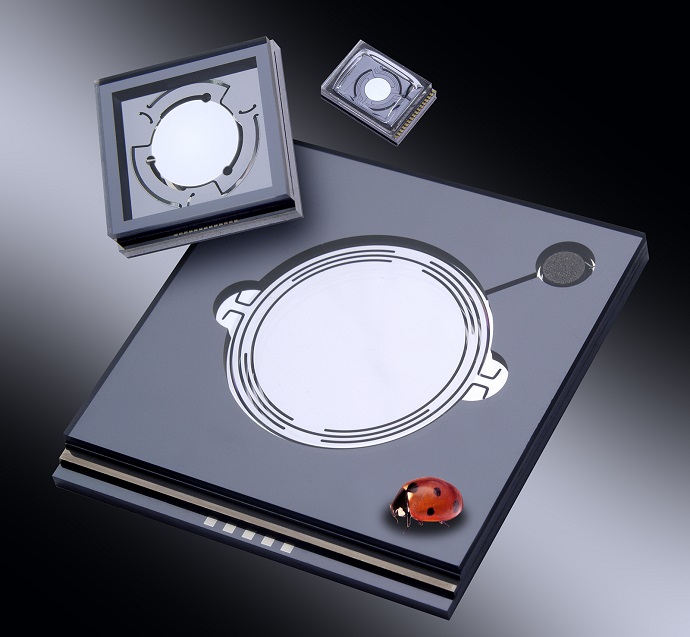May 28, 2015
Silicon micromirrors can guide laser beams at extremely high speeds, allowing operators to dose heat input to workpieces with absolute precision. But to date they have not been robust enough to be used for laser cutting and welding. Now a Fraunhofer team has managed to develop fast, durable mirrors that are capable of performing challenging cutting and welding tasks. During the LASER World of Photonics trade show from June 22 to 25, 2015 in Munich, the researchers will be presenting several of these MEMS mirrors (Hall B3, Booth 341 and Hall A3, Booth 121).
In today’s automotive and aircraft manufacturing industries, a variety of materials such as aluminum and special high-strength steels are used in order to reduce vehicle weight and hence fuel consumption. However, these new materials, and combinations of them, are presenting manufacturers with new challenges. This applies above all to the cutting and welding of metals using lasers. Until now, laser systems have had to be painstakingly adapted to individual materials. In many cases, this requires special optics that are installed specifically for a particular process.
New laser mirrors that were jointly developed by engineers at the Fraunhofer Institute for Silicon Technology ISIT in Itzehoe and the Fraunhofer Institute for Material and Beam Technology IWS in Dresden now offer greater flexibility in laser processing. Micromirrors etched from silicon are at the heart of the flexible laser system. Experts refer to them as microelectromechanical systems (MEMS). These MEMS mirrors are scanning mirrors whose job is to deflect the laser beam and guide it precisely over the workpiece. Up to now, it has been possible to use these small mirrors only with laser outputs of a few milliwatts. This was enough for head-up displays on car windshields, but not for laser cutting and welding. Higher outputs would have melted the mirrors. Thanks to a new protective coating developed in the cooperative project and a special mounting, the mirrors are now able to withstand even laser powers in the kilowatt range – enough to process aluminum or sheet steel.
Greater flexibility with micromirrors
A major advantage of the thin MEMS mirrors is that they can be swiveled back and forth at extremely high speeds, reaching frequencies of up to 100,000 hertz. This allows the laser energy to be distributed much more effectively than with conventional laser systems, whose mirrors swivel at only around 1,000 hertz. Lasers have a specific energy profile in their focal point and always input the same amount of energy. If the mirror swivels slowly, the energy cannot be distributed and dosed as effectively at the weld. “By contrast, rapid oscillation of the laser beam allows us to distribute the heat and adjust it to the respective processing task much more effectively,” says Dr.-Ing. Andreas Wetzig, specialist in the laser ablation and cutting department at Fraunhofer IWS.
As demonstrated by laboratory experiments, the MEMS mirrors open up all kinds of possibilities, including for cutting, welding, and surface hardening. “We can weld together aluminum and copper, for example, and use the heat input to precisely control which metal heats up more and thus makes up more of the melt,” says Wetzig. The mirrors also make it easier to weld aluminum alloys alone. At present, aluminum weld seams are often porous, because certain substances outgas from the alloys and form bubbles during the welding process. With the micromirror, heat input can be controlled so that the melt remains liquid until the substances have completely outgassed.
Although the solid-state lasers currently available can cut metals very well, the cut edges do not match up to the quality habitually achieved when cutting with CO2 lasers. Targeted heat input using MEMS mirrors improves edge roughness and avoids burr formation on the underside of the cut edge.
The ability of the new MEMS micromirrors to work with big laser outputs is due not only to their special reflective coating, but also to their unusual size. Normally, MEMS mirrors have a diameter of 1 to 2 millimeters. The new MEMS mirrors have diameters of up to 2 centimeters, enabling them to handle even lasers with larger beam diameters and significantly higher output. For the developers, the challenge consisted in achieving high frequencies despite the size. “To address this issue, we operate the mirrors in air-evacuated vacuum pods in order to minimize attenuation of the oscillating mirror,” says MEMS mirror expert Ulrich Hofmann at Fraunhofer ISIT. During the LASER World of Photonics, he and his colleagues will be presenting several of the new mirrors.














